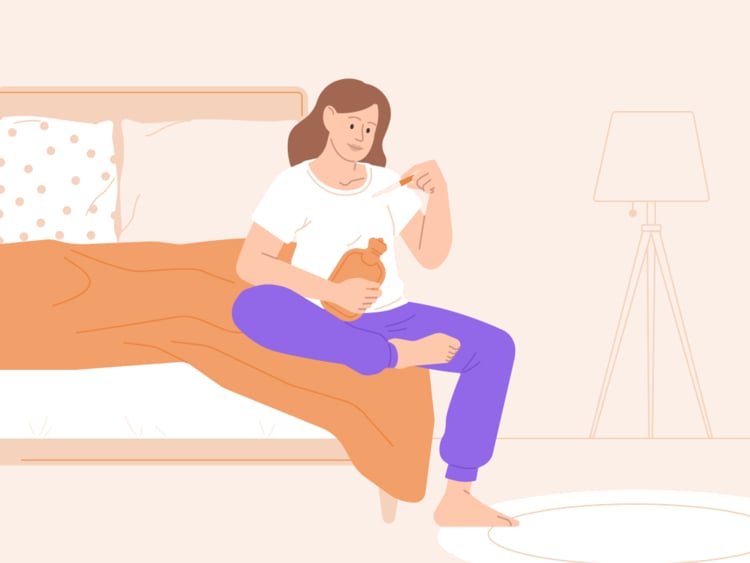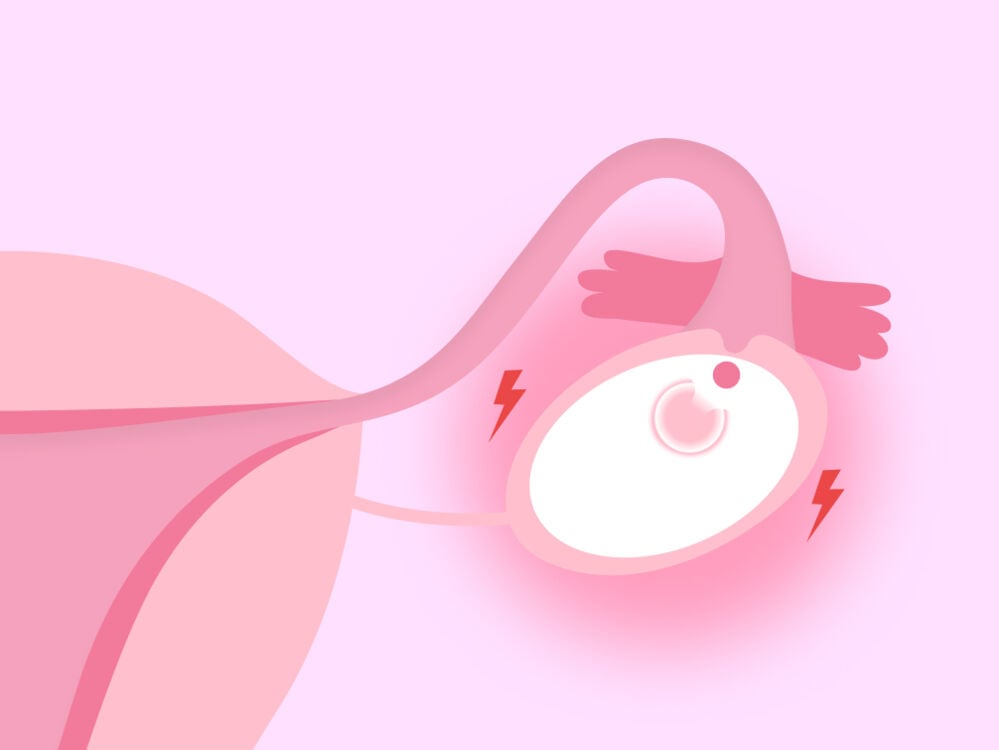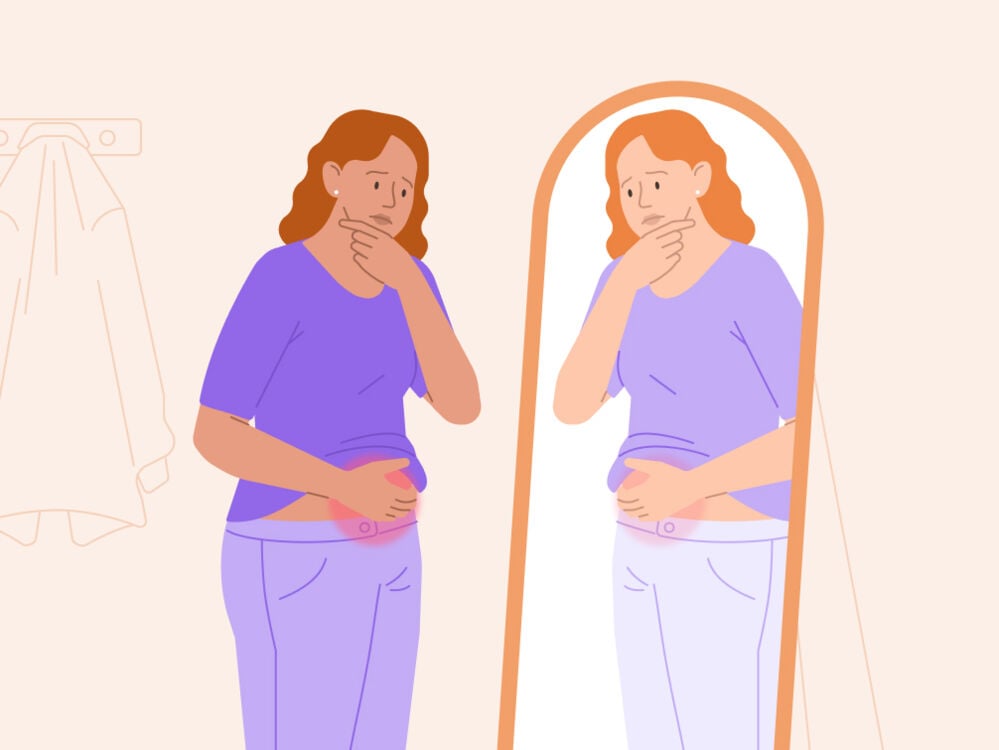Find out whether you might be experiencing ovulation pain and what you can do about it, with advice from a Flo expert.
-
Tracking cycle
-
Getting pregnant
-
Pregnancy
-
Help Center
-
Flo for Partners
-
Anonymous Mode
-
Flo app reviews
-
Flo Premium New
-
Secret Chats New
-
Symptom Checker New
-
Your cycle
-
Health 360°
-
Getting pregnant
-
Pregnancy
-
Being a mom
-
LGBTQ+
-
Quizzes
-
Ovulation calculator
-
hCG calculator
-
Pregnancy test calculator
-
Menstrual cycle calculator
-
Period calculator
-
Implantation calculator
-
Pregnancy weeks to months calculator
-
Pregnancy due date calculator
-
IVF and FET due date calculator
-
Due date calculator by ultrasound
-
Medical Affairs
-
Science & Research
-
Pass It On Project New
-
Privacy Portal
-
Press Center
-
Flo Accuracy
-
Careers
-
Contact Us
Painful ovulation: What does it feel like, and is it normal?


Every piece of content at Flo Health adheres to the highest editorial standards for language, style, and medical accuracy. To learn what we do to deliver the best health and lifestyle insights to you, check out our content review principles.
If you keep getting cramps midway through your cycle, ovulation pain (also known as mittelschmerz) could be the cause.
While cramping around your period is pretty widely talked about, you might not have heard of ovulation pain before. However, as annoying as it can be, ovulation pain is normal, affecting up to 40% of women and people who have periods.
“It is very common and normal to have pain during ovulation,” says Dr. Sara Twogood, obstetrician and gynecologist, Cedars-Sinai Medical Group, California, US. “Not everyone does though (and if you do not feel pain, that is not a problem either!).”
Of course, it can be tricky to distinguish one type of ache and pain from another. So let’s explore what ovulation pain can feel like, plus what it means if you’re trying to conceive.
Key takeaways
- Ovulation pain is common and can feel like a sharp, sudden pain or dull ache.
- As ovulation pain signals that your body has just released an egg, it can be a sign that you’re at your most fertile — a handy indicator from your body if you’re trying for a baby.
- Ovulation pain can last from a couple of hours to a day or two and rarely requires any medical treatment. Things like over-the-counter pain medication, a warm bath, or heat packs can help ease the pain at home.
Why you might experience pain during ovulation
The exact cause of ovulation pain is unknown, but doctors believe it’s likely related to the physical changes that happen during ovulation. Before we unpack why you might be experiencing pain, let’s go over what ovulation is.
During the first half of your cycle, a hormone called follicle-stimulating hormone causes follicles (which are small sacs of fluid in your ovaries containing developing eggs) to mature.
One of these follicles goes on to form a fully mature egg.
Around day 14 in an average 28-day menstrual cycle, your body produces a surge of luteinizing hormone, which causes that follicle to burst and release its egg.
This happens every cycle, and you may not even be aware it’s happening. However, in the process of releasing an egg, the surface of your ovary can stretch. This could be the cause of ovulation pain.
Take a quiz
Find out what you can do with our Health Assistant
That’s not the only possible cause. Interestingly, fluid or blood that’s released by the follicle (after it releases your egg) could also be the reason behind your ovulation pain.
“In addition to the egg, the dominant follicle contains some fluid,” explains Dr. Twogood. “When ovulation occurs, this follicle can rupture or leak, and that fluid can irritate the inner lining of the abdomen and pelvis. Ovulation may also cause the ovary to bleed, forming a structure called a hemorrhagic cyst. That blood and cyst on the ovary can also cause pain and irritation.”
Ovulation usually happens around 14 to 16 days before the start of your period, regardless of the length of your cycle. So, if you tell your doctor you’re experiencing cramping around then, they might determine that you’re experiencing mittelschmerz based on the timing of your pain.
They may also want to do some tests to rule out other possible causes, just to be sure there isn’t something else going on.
Is ovulation pain the same as period pain?
While cramping around ovulation might feel similar to symptoms related to premenstrual syndrome (PMS), Dr. Twogood explains that they’re absolutely not the same.
“Ovulation pain occurs at the time of ovulation, which is about 14 days before the start of your next period on average,” says Dr. Twogood. “PMS cramps start a few days before your period starts and then may continue as period cramps from the bleeding.”
The location of your pain can also be a useful telltale sign as to whether it’s caused by ovulation or your period.
“PMS cramps tend to be generalized and at the center of your abdomen as opposed to ovulation pain, which is usually on one side,” says Dr. Twogood. This is because your ovaries sit on either side of your abdomen, and only one will release an egg each cycle.
What does ovulation pain feel like?
What ovulation pain feels like can vary, and you may not feel it every month. In fact, some people never experience ovulation pain.
Others who do get mittelschmerz say the pain can be sharp and sudden or dull and achy like period cramps. Sometimes, the pain can feel severe, but this is rare.
“The pain is usually sharp, and people may also feel a general sense of low abdominal fullness or bloating,” adds Dr. Twogood. “It is typically on one side, although the side changes from month to month because ovulation usually alternates from one ovary to the other.”
Mittelschmerz can sometimes be accompanied by other symptoms, including:
- Pain in your lower back
- Nausea if the pain is severe
- Light vaginal bleeding or discharge
Some of these symptoms can be tough to deal with, so if you’re experiencing any of the above, make sure you go easy on yourself.
While ovulation pain may not get talked about as much as uncomfortable PMS or pregnancy symptoms, remember, it is common. You’re definitely not alone. And if you’re at all worried, then book a checkup with your doctor.

How long will I feel like this?
If ovulation pain is getting you down, know that chances are, it’ll be over quickly. “Ovulation pain is usually brief (lasting up to an hour) and resolves on its own, but sometimes it may linger for a few days,” says Dr. Twogood.
Logging the twinge or cramps in an app like Flo can help you track ovulation and monitor your symptoms. Over time, this can help you get to know your body better. You can find out more about ovulation-tracking tips here.
Is it too late to conceive if you feel ovulation pain?
If you’re trying for a baby, ovulation pain can actually be a sign that it’s a good time to have sex to conceive. The pain may be signaling that your egg has been released and that it will start its journey through your fallopian tube, where it could get fertilized by a sperm.
So how long does ovulation last? “The egg stays viable up to 24 hours after ovulation, so there is still a chance of pregnancy after ovulation pain,” explains Dr. Twogood.
However, to maximize your chances of conceiving, ideally, you’d have sex regularly during the five days leading up to ovulation as well as the day after. This seven-day period of your menstrual cycle is what’s known as the fertile window.
Logging your periods and symptoms in an ovulation-tracking app like Flo can help you predict your fertile window more accurately. But remember: ovulation tracking should never be used as birth control.

What to do about ovulation pain
So now that you know ovulation pain is normal and usually ranges from feeling like a sharp twinge to dull cramps, let’s take a look at which treatments can help you manage it.
Tips for treating ovulation pain at home
You can take over-the-counter pain relief medication to ease ovulation pain, like nonsteroidal anti-inflammatory medications (like ibuprofen) or acetaminophen. Dr. Twogood also recommends the following tips for treating the pain at home:
- Gentle stretching or exercise
- Heat packs
- Warm baths
- Staying well hydrated
- Avoiding foods that make you bloat or give you gas, like broccoli or soda
When to see a doctor about pain during ovulation
Usually, ovulation pain goes away on its own and doesn’t need any treatment. However, sometimes it’s a good idea to speak to your health care provider. “Symptoms that should prompt a doctor visit are pain that does not resolve on its own, or if other symptoms are present, such as fever, nausea or vomiting, or dizziness,” says Dr. Twogood. “These symptoms would not be usual for straightforward ovulation pain so would warrant more evaluation.”
You may also want to speak to your doctor if your ovulation pain is severe. They might recommend that you start taking hormonal contraception. Including options like the pill, hormonal intrauterine devices, and the implant, hormonal birth control can prevent you from ovulating.
This may help put an end to your monthly ovulation pain while protecting you from pregnancy. Remember, you’ll still need to use a condom to prevent sexually transmitted infections, though. If this sounds like it could work for you, chat with your health care provider about which type of contraception might be best.
However, as ovulation pain is very rarely severe, more intense pain could be a sign of an underlying condition like endometriosis (when tissue similar to the lining of your uterus grows in other parts of the body) or ovarian cysts (when harmless, fluid-filled sacs form on your ovaries). So make sure you discuss your symptoms with your doctor so they can figure out what’s going on.
More FAQs
Why do I feel so bad around ovulation?
Unfortunately, some symptoms of ovulation aren’t all that fun. As well as ovulation pain, you may experience mood changes, tender breasts, bloating, light bleeding or spotting between periods, and appetite changes.
So feeling bad around ovulation can be normal, making it a good time to take things easy and focus on some extra self-care.
Do ovulation cramps get worse with age?
“Ovulation pain is most often reported in younger women, typically those in their early 20s,” says Dr. Twogood. “My patients have also reported more ovulation pain after a pregnancy — but this is anecdotal.”
What does ovarian cyst pain feel like?
Most ovarian cysts don’t cause any symptoms, but if a cyst is big, it can cause a sharp pain or dull ache.
Ovarian cyst pain is usually located in the lower abdomen, toward one side, and will come and go rather than occur during the time of ovulation.
You might also experience bloating or a feeling of fullness, pressure, or heaviness in your belly. Ovarian cysts are usually harmless, but you should speak to your health care provider if you think you might have them.


Hey, I'm Anique
I started using Flo app to track my period and ovulation because we wanted to have a baby.


The Flo app helped me learn about my body and spot ovulation signs during our conception journey.


I vividly
remember the day
that we switched
Flo into
Pregnancy Mode — it was
such a special
moment.
Real stories, real results
Learn how the Flo app became an amazing cheerleader for us on our conception journey.
References
“Abdominal Pain.” Mayo Clinic, 15 July 2023, www.mayoclinic.org/symptoms/abdominal-pain/basics/causes/sym-20050728.
Brott, Nathan R., and Jacqueline K. Le. “Mittelschmerz.” StatPearls, StatPearls Publishing, 1 May 2023, www.ncbi.nlm.nih.gov/books/NBK549822/.
“Contraception.” Centers for Disease Control and Prevention, 13 Dec. 2023, www.cdc.gov/reproductive-health/contraception/.
Charlewood, G. P. “Mittelschmerz or Ovulation Pain.” Suid-Afrikaanse Tydskrif vir Geneeskunde [South African Medical Journal], vol. 32, no. 10, Mar. 1958, pp. 261–62.
“Endometriosis.” The American College of Obstetricians and Gynecologists, Feb. 2021, www.acog.org/womens-health/faqs/endometriosis.
“Fallopian Tubes: Is Pregnancy Possible with Only One?” Mayo Clinic, 9 Feb. 2023, www.mayoclinic.org/diseases-conditions/female-infertility/expert-answers/pregnancy/faq-20058418.
“How to Get Pregnant.” Mayo Clinic, 11 Dec. 2021, www.mayoclinic.org/healthy-lifestyle/getting-pregnant/in-depth/how-to-get-pregnant/art-20047611.
“Ovarian Cysts.” Mayo Clinic, 28 July 2023, www.mayoclinic.org/diseases-conditions/ovarian-cysts/symptoms-causes/syc-20353405.
“Ovarian Cysts.” The American College of Obstetricians and Gynecologists, Nov. 2021, www.acog.org/womens-health/faqs/ovarian-cysts.
“Ovulation.” Cleveland Clinic, my.clevelandclinic.org/health/articles/23439-ovulation. Accessed 16 May 2024.
Witt, Barry. “Trying to Get Pregnant? Here’s When to Have Sex.” The American College of Obstetricians and Gynecologists, Aug. 2023, www.acog.org/womens-health/experts-and-stories/the-latest/trying-to-get-pregnant-heres-when-to-have-sex.




